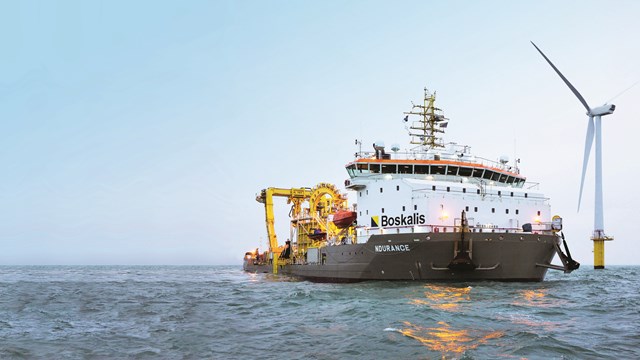Channel Islands Electricity Grid, a joint venture between Jersey Electricity and Guernsey Electricity operate several interconnecting power cable systems (power and telecom) between Jersey, Guernsey and France. Both Jersey and Guernsey rely upon the services of these interconnecting power cables and as a consequence there is a demand to reduce the possible effects and impact of failure to these interconnecting power cables. Boskalis were contracted to conduct a preemptive repair replacing a section of cable including the installation two subsea joints on the Guernsey Jersey circuit, close to Havelet bay.
SCOPE OF WORK
- Mobilisation of cable repair vessel and auxiliary equipment
- Mobilise cable storage pan and turntable onto transpooling barge
- Load spare cable from the storage pan onto the Ndurance
- Determine cable cut position along cable route
- Cut, test and seal operations
- Removal of sea end cable till jointing location
- Cut cable and joint to new cable section
- Lay down joint No.1 on sea bottom and lay new section of cable
- Recover shore end and joint both cable ends
- Lay down joint No.2 and omega on sea bottom
- Post lay ROV survey
Having signed a Power Cable Maintenance Agreement (PCMA) in the summer of 2012, Boskalis maintains a long standing relationship with Channel Islands Electricity Grid (CIEG). The parties involved in the agreement have worked together to achieve a quick response method for maintaining and where necessary repairing the subsea assets that are so vital for the islands communities.
In November 2014 Boskalis was instructed to mobilise for a preemptive repair after CIEG had detected a potential vulnerability in the subsea cable, which provides a power link to the Island.
Extensive and detailed engineering was carried out over the Christmas and New Year period, owing to the very difficult repair area.
The large tide range and strong, unpredictable currents around the shallow rocky outcrops of Havelet Bay created a number challenges during the engineering phase. Being a winter repair in the English Channel the planning for the project was critical. Mobilisation of the CLV “Ndurance” started on the 12th January with the cable being loaded from the Boskalis storage only 5 days later. The vessel arrived in Havelet bay, Guernsey on the 21st January to start the repair operations after 48 hours of DP familiarisation along the challenging route. The repair operation was broken into sections to ensure that each operation could be complete once it had been committed to. The repair was completed on schedule and to the satisfaction of all parties on the 5th February 2015.
Guernsey Electricity issued a statement which commended the professionalism and efficiency of Boskalis throughout what was a challenging repair in a difficult period.

